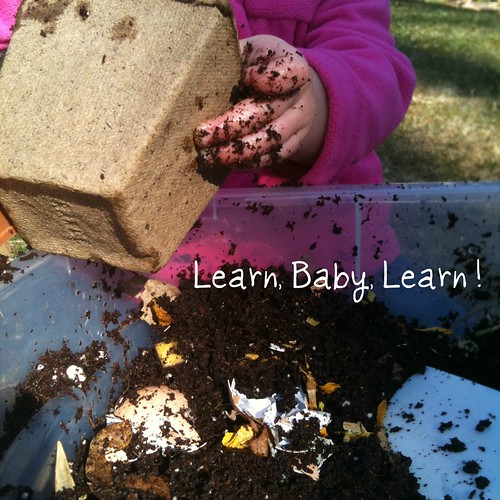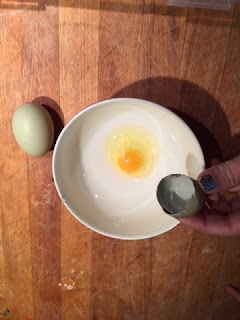Pin It
Look at those happy ladies, stalking me for treats. They free range occasionally and I get them greens every day in the winter, but most of what they eat is feed. So what do I give my chickies?
I must have read a few dozen recipes of homemade chicken feed by now, ranging from people who swear by crumble over pellets, fresh meat or live insects, dried herbs and hot peppers. Most are precise and all are certain in their amazingness.
I'm not that organized.
Here is what I've learned mature chickens should eat, and why:
Feed, either pellets or crumbles. Both have advantages, and this is the mainstay of their food. Some is organic, some boasts added omega-3.
Oyster shells - These should always be available once chickens are nearing maturity. I keep mine in a
PVC pipe not unlike this.
Herbs - Like for humans, herbs are great for chickens. I always add some garlic powder into their feed, since they don't like it fresh or in water, despite my best efforts.
Here is a helpful guide to which herbs are useful where in the coop. In the summer, the chickens have the herb garden to benefit from. I hung some oregano to dry this fall, and we've just run out.
Grains and seeds - Remember when chickens were wild? No? Neither do I. But given the chance, chickens will scratch and peck for grains and seeds all day long. Variation is what gives chickens tasty eggs. Oats, flax, wheat berries (or wheat grain), sunflower seeds, sesame seeds, and dried lentils or split peas are just a few of the grains our birds enjoy. I toss in whatever I have on hand, or bought at the grain store. If you don't have a grain store or gobs of money, buy these from a bulk supplier online. Buying flax and wheat berries at a grocery store will cost you, easily, four times as much. I do buy the oats and seeds at the grocery store, though.
Brewer's Yeast - My dog and cat go nuts for this stuff. I had a giant jar from when I was nursing J, and as much as I loved lactation cookies, I don't need to keep eating them now that she is weaned. I kept the yeast, though, because it is great for flea prevention in pets. What's good for the goose is good for the gander, and Brewer's Yeast is packed with B12. (So much so that too much can cause acne.) I put some in the chicken food for the nutrients and the repelling properties, not that we've had an issue with pests, yet.
Corn - I read so much about chickens loving corn and being careful how much is offered that I was a bit disappointed when my girls didn't lose their minds over it. They do like it, but they don't go to town like the do on a container of meal worms or wheat grass. In the winter, corn is more important, as it helps keep them warm as they digest it. I add it to their feed in the winter for this very reason. It also adds color to the yolks.
Kelp - This is supposedly the holy grail of chicken feed. Seaweed is chock full of great minerals and vitamins. It makes their feathers silky, their eyes bright, their waddles red, and helps boost their health overall. I toss some in there. They like it. It is expensive, but one small bag lasts quite a while when you are mixing it in. Just don't go to Whole Foods to buy your chickens kelp.
Scraps - Chickens are composters. I give them the kitchen scraps. It cuts down on waste, cuts down on what I spend on chicken food, and cuts my trip to the compost pile in half.
Greens - Everything outside is brown right now. Chickens like greens. Whenever I grocery shop, I ask the produce people if they have any "shrink" that they will give to me for my chickens. Some stores will tell you that they can't give you any past date food because they are worried you will consume it (which is ridiculous, because if they are going to toss it in the trash because it is bruised, they might as well give it to someone asking for help... or chickens) but plenty of stores will gladly haul out some wilted greens or heads of lettuce or boxes of sprouts that are at their date, and most are completely fine still. When that fails me, I buy whatever greens are on sale that week. If the weather is in the 20s or lower all day, I get some iceberg lettuce and cucumbers. Both hold a great deal of water, so if I can't be around and the water freezes, the ladies have a backup.
Protein - Italian farmers feed their chickens protein. It is the secret to rich, hearty yolks. The other day, I made chicken stock with a whole frame, some meaty bones, and plenty of vegetables. When I was done, I set the strained scraps out to cool before tossing them. Next thing I know, Dotty is racing through the yard with a bone in her mouth, and five other ladies are darting after her. They ate every last bit of meat in that bowl. Chicken meat. Cannibalism is disturbing to us, but they didn't care one bit, and it was from a really great, organic, roasted bird. Better to them than the garbage can, right? Usually their additional protein comes from tried meal worms, but sometimes I will give them fresh meal worms, and they just go crazy for those. They were also the lucky recipients of some salmon before a vacation, and it was more or less Christmas for them.
I used to keep the pellets separate and mix the other dry elements together as scratch, but I found that much of the small stuff was lost that way. Here is what I do now.
NOTE: This is layer feed, for chickens ready to or actively laying eggs.
I fill the bottom of my bin with whatever "scratch" items I'm going to add. This time it was cracked corn, hulled and unhulled sunflower seeds, some dried meal worms (a lady had some molt going on, and I want to be sure they all have a little boost for new feathers... this makes up maybe 2% of the final mix), oats, wheat berries, garlic powder, and brewer's yeast.
Snap the lid on and do a few kettle lifts with the container. Voila! Variegated, healthy food for the ladies that costs less when you mix it yourself!
They hear the food shaking...










































